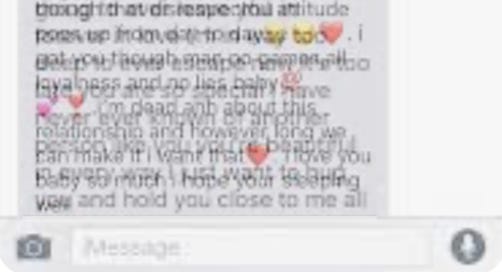It’s 2015. You’re wearing a sweatshirt too tight for you. You are waiting for a bus to take you to middle school. Your friend, or really someone who just lives near you, gets a text from her boyfriend. The text is so long it requires an arrow at the bottom which tabs to a separate page. Your dear friend immediately screenshots and your heart is racing even being two steps to the left of the experience. The Paragraph is filled with professions of love so sugary they had to have come from a 13-year-old and broken up with multicolored heart emojis.
This is a “Paragraph” a type of message with some locally specific connotations of socially signally love that was deeply a part of my late middle school/ early high school life. These messages were the standard of any good relationship. I sent them for birthdays, I hoped to receive them from crushes, then turned on them as over the top and “fake” (2016’s worst crime) within the ages of 13-15. The focus was length. You wanted that other page, the content was less important.
The idea of these juvenile late 2010s love letters is sweet in my memory. The verbalization of friendship and love is clearly important to people, but showing this love verbally remains hard even for the most practiced people. Sally Rouny’s book Normal People is one of the best and most popular examples of this. Communication is blocked by class, gender, and fear of vulnerability. They write emails to each other at one point, and these hugely contrast their real-life conversations, with long sincere messages, articles, and descriptive updates. Rooney also applied this practice to her more recent work, Beautiful World Where Are You. Her main characters write back and forth to each other. You can feel the closeness and/or distance between them through that. Letters to a young poet, Frankenstein, Pride and Prejudice. Letter writing remains a huge park of fictional characters’ worlds, often reflecting their time period’s primary form of communication. At the time when some of those were written, a lengthy letter was necessary since it took so long to arrive. But in the age of emails, a long email means something different.
John Green and Sarah Urist Green exchanged emails for a year before dating. Green said in an article from the New Yorker, “It was one of the most invigorating conversations I can remember having”. In our current time, the length of the messages no longer has the social power it once did. I would argue frequency, is the new rage. How often do you text your significant other, how long does it take them to respond ect.
There is something so tangible and lovely about a letter. But emails to me are the perfect balance of technologically fast, and truly meaningful communication. You can provide links, attach photos. Unfortunately, email inboxes are a scary place. Most people’s are filled with promotions, assignments, and subscriptions ( except for of course the bright light that is my substack newsletters). Maybe a long and thoughtful email from a dear friend/lover would liven up the space. Maybe it will find the sweet spot between slow-living 18th-century epistolary culture and late 2010s emoji-littered paragraphs.






